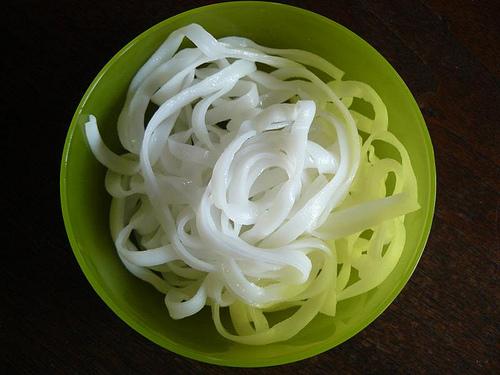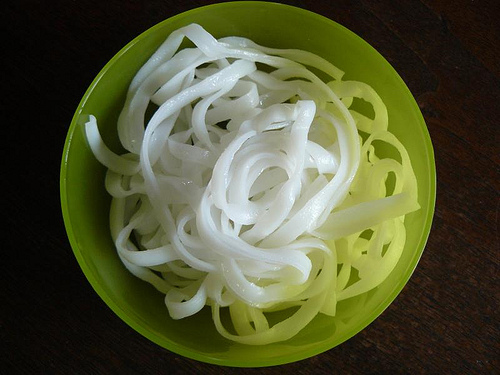
Wait, had I been living a faux pho life all these years? No, child, the dried ones available here are good and convenient to keep on hand when you have a neighborhood noodle vendor around the corner. Duh, like pho. Indeed, go to Vietnam today and you’ll find freshly made noodles sold at markets and used at noodle joints. In the U.S., fresh noodles aren’t as readily available, but there are dried noodles that cook up wonderfully.
Our conversation earlier this week on defining faux pho spurred me to continue my (occasional) series of posts of Vietnamese noodles. Also, a couple of days ago, I noticed a young woman struggle with trying to find banh pho noodles at an Asian market. She got flat noodles but they were made of mung bean starch. I hope this guide will help you buy and use this ubiquitous Vietnamese noodle.
Banh Pho Buying Guide: Dried and fresh rice noodles
Available in small, medium, and large widths, banh pho noodles are available dried and fresh. The dried variety, technically called banh pho kho, is easier to find cooks up to a terrific chewy texture that’s nearly as good as fresh. Keep several fourteen- or sixteen-ounce packages of each width in the pantry to make noodle dishes on demand. If the sizes are not printed on the packaging, think of the noodles as Italian pasta:

- Small is the width of linguine (⅛ inch) or narrower: use for noodle soup
- Medium is roughly the width of fettuccine (¼ inch): use for noodle soup or stir-frying
- Large is about the width of pappardelle (½ inch): use for pan-frying or stir-frying
Depending on the application, the dried noodles may be soaked first and then stir-fried or plunged into boiling water. They may also simply be boiled. Check your recipe for how you should prep dried banh pho noodles.
Nearby there are usually wide fresh rice noodles that are the same as thick Chinese fun noodles. Often labeled banh hu tieu (the Viet term for Chinese rice noodles), they’re just banh pho. Though I seldom use them, uncut sheets of fresh rice noodles are called banh uot, which may be used to roll up foods such as grilled beef with lemongrass. Freshly made banh pho sold on Styrofoam trays are best if purchased soft and at room temperature, essentially soon after they’re delivered to the market. Eat them the day you buy them for an amazing taste treat.
Where to buy banh pho rice noodles:
- Dried and maybe fresh too: Chinese and Southeast Asian markets
- Dried only: Trader Joe’s, Whole Foods, check Asian/ethnic/Oriental aisle at supermarkets
Alternate names for banh pho rice noodles: Rice sticks, Chantaboon/Jantaboon, pancit bihon, sen lek (narrow), sen yai (wide), how fun
Suggested brands: Three Ladies, Caravelle, Bangkok Elephant
Related links:
- Vietnamese Noodles 101: Banh Hoi Fine Rice Noodles
- Rice Noodles Stir-fried with Chinese Chives, Shrimp and Pork (Banh Pho Xao He) Recipe
- Beef Pho Noodle Soup (Pho Bo) Recipe
- Chicken Pho Noodle Soup (Pho Ga) Recipe
Have tips to add or questions to ask? Do include them below!
